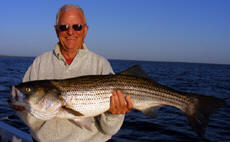 |
|
|
Fishing Techniques. Jigging with Soft Plastics. Using weighted or unweighted jig heads and soft plastic bodies to mimic a variety of baitfish available to the stripers and blues. As with plugs, the technique used in retrieving these baits is the key to getting the predators to strike. Baitfish cannot swim at high speeds for long periods, they go fast, then slow down and predators will often hit when they slow down. Emulating this will result in more fish caught. I've seen plenty of times when only one or two people can get the technique down and they catch fish while no one else does. Butterfly and Diamond jigging. Using 3-5 ounce jigs, we drop them to the bottom and reel them up, again using a variety of retrieve styles to get the fish to strike. The most successful one is three cranks on the reel and stop for about 1 second, then repeat until you get it to the surface. This style usually only works in water that is 40' or deeper. In shallower water there is more light and the jig may not appear life like enough for the fish to strike. I have not had much success using this type of jig in shallower water. Drifting. The vast majority of the time we drift when fishing, and plug, or use soft plastics or diamond jigs. Normally we drift with the engine off, positioning the boat up drift of where the fish are, then drift through them while casting and retrieving plugs or soft plastics, or drop diamond jigs down and retrieve them. Its important to know the tide direction and the location of the fish. Also, you never motor through where the fish are hanging unless the water is very deep, and even then you do it at a rel;atively low speed, not at full cruising speed. Trolling. This is one of the last techniques we would use, normally when either our clients cannot master any other technique or we find it is the only way we can catch the fish. Sometimes it is necessary to retrieve a plug or butterfly jig so fast that it quickly wears you out. This is another time when we would troll, as it is easy to make a lure go fast when trolling. Normally we troll with 2 lines and use wire line rods with umbrella rigs, spoons, or parachute jigs. While this type of fishing can be very productive it isn't nearly as much fun catching them on wire line rods versus catching then on light tackle and having the rod in your hand when the fish hit. Run and Gun. There are times when fish and birds are chasing bait and we try to chase them to get in close and cast to the breaking fish. Most of the time we'd attempt to get updrift in this case, but it doesn't always work out that way. When doing run and gun, the clients must be prepared to immediately cast to the fish even before the boat has come to a full stop. Bottom Fishing. This type of fishing is normally associated with using bait and sinkers to get the rig al the way to the bottom, where the fish would be. We often drift for this type of fishing, but will also anchor the boat over structure depending on the type of fish we target. . |
|
|
Copyright c 2012 It's Fishing Time Rhode Island Fishing Charters |
|




